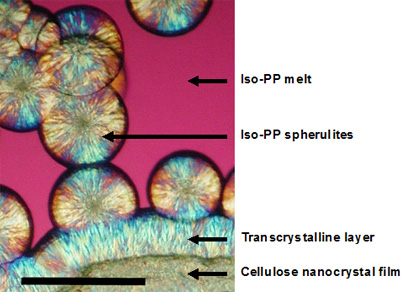One possible application of cellulose nanocrystals is as reinforcement for thermoplastic polymers. Effective composite materials require a strong bond between cellulosic fibre and polymer matrix. This is normally achieved by means of a reactive coupling agent. Now, natural cellulose fibres nucleate the crystallization of polypropylene, forming a characteristic "transcrystalline layer" along the fibre ["Polypropylene transcrystallization at the surface of cellulose fibers," D.G. Gray., J. Polym. Sci., Polym. Lett. Ed., 12, 509-515 (1974)]. Do cellulose nanocrystals also nucleate the crystallization of polypropylene? It is difficult to effectively blend cellulose nanocrystals in the bulk polymer, so we looked for surface nucleation at the edge of nanocrystal fims, and at the surface of glass slides where nanocrystals has been deposited. The results were clear; an intense nucleation was observed in both cases ["Transcrystallization of polypropylene at cellulose nanocrystal surfaces", D.G. Gray, Cellulose, 15(2), 297-301 (2008)]. The implications for composite strength are less clear!

Edge of cellulose nanocrystal film in contact with isotactic polypropylene (iso-PP) melt. Crossed polars, Crossed polars, first-order red plate. Scale bar, 200 µm.